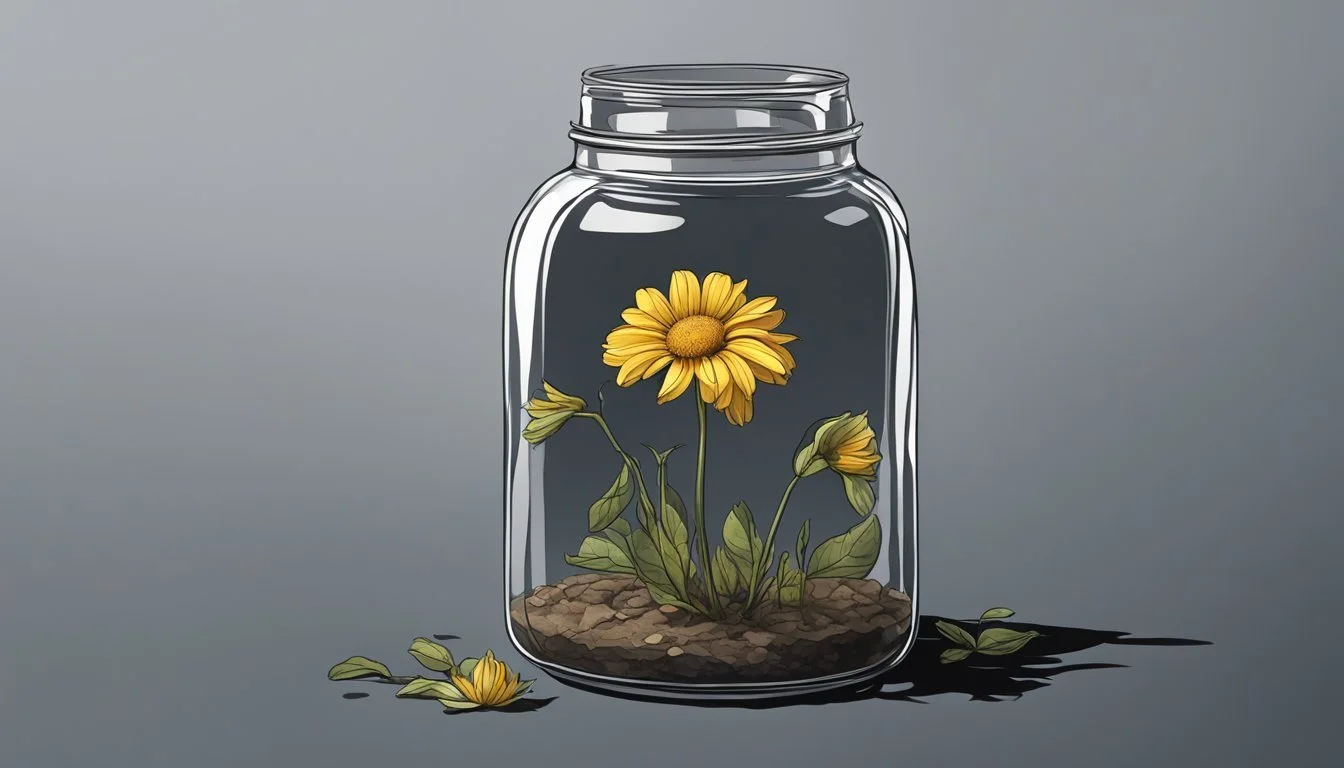Breaking Free: Overcoming Isolation in Toxic Relationship
Toxic relationships can profoundly impact a person's life, often leading to isolation from friends, family, and support systems. This isolation is not accidental but a deliberate tactic used by abusive partners to maintain control and power over their victims. Isolation in toxic relationships serves as a warning sign of emotional abuse and can have severe consequences for mental health and well-being.
Recognizing the signs of isolation in a toxic relationship is crucial for breaking free from its damaging effects. These may include a partner who discourages outside friendships, criticizes family members, or monitors communications with others. As the relationship progresses, the victim may find themselves spending less time with loved ones and more time solely with their abusive partner.
The effects of isolation in toxic relationships extend beyond emotional distress. It can lead to increased dependence on the abusive partner, making it harder to leave the relationship. Additionally, isolation can exacerbate feelings of loneliness, depression, and anxiety, further trapping the victim in a cycle of abuse.
Understanding Toxic Relationships
Toxic relationships are characterized by harmful patterns of behavior that negatively impact the well-being of those involved. These dynamics can manifest in various forms, often leaving individuals feeling drained, undervalued, and emotionally distressed.
Defining Toxic Relationship Dynamics
Toxic relationships are marked by persistent negativity, lack of support, and emotional manipulation. One partner may consistently undermine the other's self-esteem through criticism, gaslighting, or blame-shifting. Control is often a key element, with one person attempting to dominate decisions, social interactions, or finances.
Emotional manipulation tactics like love bombing followed by withdrawal of affection are common. This creates an unpredictable environment where the victim feels constantly on edge.
Disrespect and lack of boundaries are hallmarks of toxic dynamics. A toxic partner may regularly invade privacy, dismiss feelings, or make unilateral decisions affecting both individuals.
Types of Toxic Relationships
Toxic relationships can take various forms:
Emotionally abusive: Involves belittling, humiliation, and manipulation
Physically abusive: Includes threats or acts of violence
Verbally abusive: Characterized by yelling, name-calling, and harsh criticism
Financially abusive: One partner controls or exploits the other's finances
Sexually abusive: Includes coercion, non-consensual acts, or using sex as a weapon
Some toxic relationships may exhibit multiple forms of abuse simultaneously. The severity and frequency of toxic behaviors can vary, but all types can have serious psychological impacts.
Recognizing Signs of a Toxic Relationship
Red flags in toxic relationships include:
Constant criticism and put-downs
Frequent arguments that never reach resolution
Lack of trust and excessive jealousy
Controlling behavior, such as dictating friendships or monitoring communications
Gaslighting and denial of reality
Emotional manipulation through guilt or threats
Lack of support for personal growth or success
Disrespect for boundaries and privacy
Physical symptoms like anxiety, depression, and sleep disturbances often accompany toxic relationships. Victims may experience a loss of self-esteem and struggle to recognize their own worth.
The Role of Jealousy and Possessiveness
Jealousy and possessiveness are common elements in toxic relationships. While some jealousy can be normal, excessive jealousy often leads to controlling behaviors and emotional manipulation.
A jealous partner may:
Constantly accuse the other of infidelity without cause
Demand access to personal devices and accounts
Isolate their partner from friends and family
React with anger or aggression to perceived threats
These behaviors stem from deep-seated insecurity and a need for control. Over time, they erode trust and create a suffocating environment for the victim.
Possessiveness often manifests as attempts to limit a partner's autonomy. This can include discouraging individual pursuits, careers, or friendships that don't involve the controlling partner.
Impact of Toxic Relationships
Toxic relationships inflict profound damage on individuals, affecting multiple aspects of their lives. These harmful dynamics create a ripple effect that extends far beyond the immediate relationship.
Effects on Mental and Emotional Health
Toxic relationships take a severe toll on mental and emotional well-being. Individuals often experience heightened anxiety and depression. Self-esteem plummets as constant criticism and manipulation erode confidence. Emotional turmoil becomes the norm, leading to persistent feelings of worthlessness and inadequacy.
Victims may develop symptoms of post-traumatic stress disorder (PTSD). Flashbacks, nightmares, and hypervigilance can persist long after the relationship ends. Trust issues often emerge, making it difficult to form healthy connections in the future.
Many struggle with intrusive thoughts and difficulty concentrating. This impacts work performance and daily functioning. Some turn to substance abuse or develop eating disorders as coping mechanisms.
Consequences on Physical Health
The stress of toxic relationships manifests in physical symptoms. Chronic headaches, muscle tension, and fatigue are common. Sleep disturbances further compound these issues.
Cardiovascular problems may arise due to prolonged stress. High blood pressure and increased risk of heart disease are potential outcomes. Digestive issues like ulcers or irritable bowel syndrome often develop.
Weakened immune function leaves individuals more susceptible to illness. Skin problems, such as acne or eczema, may flare up. Some experience unexplained weight changes or loss of appetite.
The Cycle of Social Isolation
Toxic partners often employ tactics to isolate their victims. They may discourage or forbid contact with friends and family. This isolation cuts off vital support systems and makes it harder to leave the relationship.
As the toxic dynamic persists, individuals withdraw from social activities. Shame or fear of judgment keeps them from reaching out. Friendships wither due to neglect or the toxic partner's interference.
Work relationships suffer as victims become distracted or withdrawn. Career opportunities may be missed. The gradual erosion of social connections leaves individuals feeling trapped and alone.
Long-Term Ramifications
The impact of toxic relationships can persist for years. Survivors often struggle with trust and intimacy in future relationships. Hypervigilance and fear of repeating past patterns may lead to avoidance of new connections.
Personal growth and self-actualization are stunted. Many find it challenging to pursue goals or explore their interests. Financial repercussions can arise from job loss or shared debts.
Some individuals develop a distorted view of healthy relationships. They may unknowingly seek out similar toxic dynamics. Others swing to the opposite extreme, becoming overly guarded or controlling.
Rebuilding self-esteem and reclaiming one's identity takes time and effort. Many require professional help to process their experiences and develop healthy coping mechanisms.
Navigating Relationships and Boundaries
Establishing clear boundaries, maintaining open communication, and fostering mutual respect are essential elements for navigating healthy relationships. These practices help create a foundation of trust and understanding between partners.
Identifying and Establishing Boundaries
Boundaries define personal limits and expectations within a relationship. They can be physical, emotional, or digital. To set effective boundaries, individuals should reflect on their needs and communicate them clearly to their partner.
Healthy boundaries might include:
Respecting personal space and privacy
Honoring each other's time and commitments
Maintaining separate friendships and interests
It's important to revisit and adjust boundaries as the relationship evolves. Partners should be willing to discuss and negotiate these limits respectfully.
The Importance of Communication
Open and honest communication forms the backbone of a healthy relationship. It involves active listening, expressing thoughts and feelings clearly, and being receptive to feedback.
Effective communication strategies include:
Using "I" statements to express feelings
Avoiding blame or criticism
Practicing empathy and validation
Regular check-ins can help partners stay connected and address concerns before they escalate. It's crucial to create a safe space where both individuals feel comfortable sharing without fear of judgment or rejection.
Building a Healthy Relationship
A healthy relationship requires ongoing effort and commitment from both partners. It's built on a foundation of mutual trust, respect, and support.
Key aspects of a healthy relationship include:
Encouraging personal growth and independence
Offering emotional support during challenging times
Celebrating each other's successes
Maintaining a balance of give and take
Partners should strive to create positive interactions and shared experiences. This can involve planning quality time together, showing appreciation, and working as a team to overcome obstacles.
Strategies for Handling Toxic Relationships
Effective strategies can help individuals navigate and overcome toxic relationships. These approaches focus on self-preservation, seeking support, and taking concrete steps toward positive change.
Developing Coping Strategies
Coping strategies are essential for managing the emotional toll of toxic relationships. Mindfulness and meditation can help reduce stress and anxiety. Journaling allows for processing complex emotions and gaining clarity.
Setting boundaries is crucial. This involves clearly communicating personal limits and consistently enforcing them. Learning to say "no" without guilt is an important skill to develop.
Self-care practices are vital. Regular exercise, proper nutrition, and adequate sleep can boost resilience. Engaging in hobbies and activities that bring joy can provide a much-needed emotional outlet.
Cognitive restructuring techniques can help reframe negative thought patterns. This involves challenging and replacing self-defeating beliefs with more balanced, realistic ones.
Creating a Safety Plan
A safety plan is essential, especially in potentially dangerous situations. It should include trusted contacts to call in emergencies and safe places to go if needed.
Gathering important documents and keeping them in a secure location is crucial. This includes identification, financial records, and legal papers.
Creating a code word with trusted friends or family can signal the need for immediate help without alerting the toxic individual.
Preparing an emergency bag with essentials like clothes, medication, and cash can provide peace of mind and readiness to leave quickly if necessary.
Documenting incidents of abuse or concerning behavior can be helpful for legal purposes or personal reflection.
Seeking Professional Help
Professional support is invaluable in navigating toxic relationships. Therapists can provide tools for managing emotional distress and rebuilding self-esteem.
Counseling offers a safe space to process experiences and gain perspective. It can help identify unhealthy patterns and develop strategies for change.
Support groups provide validation and shared experiences. They can reduce feelings of isolation and offer practical advice from others who have faced similar challenges.
In some cases, psychiatric evaluation may be necessary to address mental health concerns that have arisen from the toxic relationship.
Legal professionals can offer guidance on rights and options, especially in cases involving abuse or shared assets.
Leveraging Support Networks
A strong support network is crucial for breaking free from toxic relationships. Trusted friends and family can provide emotional support and practical assistance.
Reconnecting with people who may have been pushed away during the toxic relationship is important. These connections can offer a sense of normalcy and belonging.
Joining community groups or classes can help build new, positive relationships. This expands the support network and provides opportunities for personal growth.
Online forums and social media groups can offer additional support, especially for those who feel isolated or have limited local resources.
Volunteering can provide a sense of purpose and connection, helping to rebuild self-worth and confidence.
Moving Beyond Toxic Relationships
Breaking free from toxic relationships requires courage and commitment to personal growth. The journey involves recognizing unhealthy patterns, healing emotional wounds, and rebuilding self-worth.
Recognizing the Need for Change
Identifying toxic relationship dynamics is crucial for initiating change. Red flags include constant criticism, manipulation, and feelings of worthlessness. Many individuals struggle with fear of being alone, which can prolong harmful situations.
Self-reflection helps in recognizing these patterns. Journaling about interactions and emotions can provide clarity. Seeking input from trusted friends or family members offers valuable outside perspectives.
Professional counseling can assist in understanding relationship dynamics. Therapists specializing in toxic relationships help clients identify unhealthy behaviors and their root causes.
Healing from Emotional Trauma
Emotional healing is essential after leaving a toxic relationship. Therapy options include cognitive-behavioral therapy (CBT) and eye movement desensitization and reprocessing (EMDR).
Self-care practices support recovery:
Daily meditation or mindfulness exercises
Regular physical activity
Engaging in creative hobbies
Maintaining a balanced diet
Support groups provide a safe space to share experiences and coping strategies. Connecting with others who have overcome similar challenges can be inspiring and validating.
Rebuilding trust is a gradual process. Starting with small acts of self-trust helps rebuild confidence in one's judgment and decision-making abilities.
Fostering Self-Empowerment
Rediscovering personal interests and values is key to self-empowerment. Engaging in activities that bring joy and fulfillment helps rebuild a positive self-perception.
Setting and maintaining healthy boundaries is crucial. This includes:
Clearly communicating personal limits
Saying "no" without guilt
Prioritizing personal needs and well-being
Developing a strong support network contributes to emotional wellbeing. Cultivating friendships and family relationships provides a foundation for healthy interactions.
Professional development or learning new skills boosts self-esteem. Accomplishments in work or personal pursuits reinforce a sense of capability and independence.
Legal and Financial Considerations
Addressing legal and financial matters is crucial when leaving a toxic relationship. Taking proactive steps can protect your rights and establish independence.
Addressing Financial Control and Independence
Financial control is a common tactic in toxic relationships. Abusers may restrict access to money or financial information. To regain financial independence:
Open a separate bank account in your name only
Gather important financial documents like tax returns and pay stubs
Create a budget to understand your income and expenses
Seek employment if you're financially dependent on your partner
Consider meeting with a financial advisor for guidance
Building an emergency fund can provide a financial safety net. Even small amounts saved regularly can add up over time.
Understanding Legal Rights and Resources
Knowing your legal rights is essential when leaving a toxic relationship. Key considerations include:
Protection orders if there's a threat of violence
Child custody and support arrangements
Division of shared assets and debts
Housing rights, especially if you're not on the lease
Consulting a lawyer specializing in family law can clarify your options. Many communities offer free legal clinics or sliding-scale services for those with limited resources.
Document any abusive behavior, including dates and details. This information may be valuable for legal proceedings. Local domestic violence organizations often provide guidance on legal matters and can connect you with appropriate resources.
The Societal View of Toxic Relationships
Toxic relationships remain a complex issue in society, often shaped by cultural norms and social expectations. Public perception of these harmful dynamics continues to evolve as awareness grows.
Challenging Stigma and Misconceptions
Many people still struggle to recognize toxic relationships, especially when they don't involve physical abuse. Common misconceptions include believing that toxicity only occurs in romantic partnerships or that victims can easily leave. These misunderstandings can lead to victim-blaming and reluctance to seek help.
Stigma surrounding toxic relationships often prevents open discussions. Some view seeking help as a sign of weakness or failure. This stigma is particularly prevalent in certain cultures that prioritize family harmony over individual well-being.
Education and awareness campaigns play a crucial role in dispelling myths. Mental health professionals and advocacy groups work to reframe toxic relationships as a serious issue requiring support and intervention.
Cultural and Social Factors
Cultural beliefs significantly influence perceptions of toxic relationships. In some societies, certain controlling behaviors may be normalized or even encouraged. Gender roles and expectations can exacerbate toxic dynamics.
Social media presents a unique challenge, sometimes glorifying unhealthy relationship patterns. The pressure to present perfect relationships online can mask underlying issues and discourage people from seeking help.
Family relationships often complicate matters. Extended family involvement can either provide support or reinforce toxic patterns, depending on cultural norms and individual circumstances.
Socioeconomic factors also play a role. Financial dependence can trap individuals in toxic relationships, while lack of access to resources may limit options for those seeking to leave.




